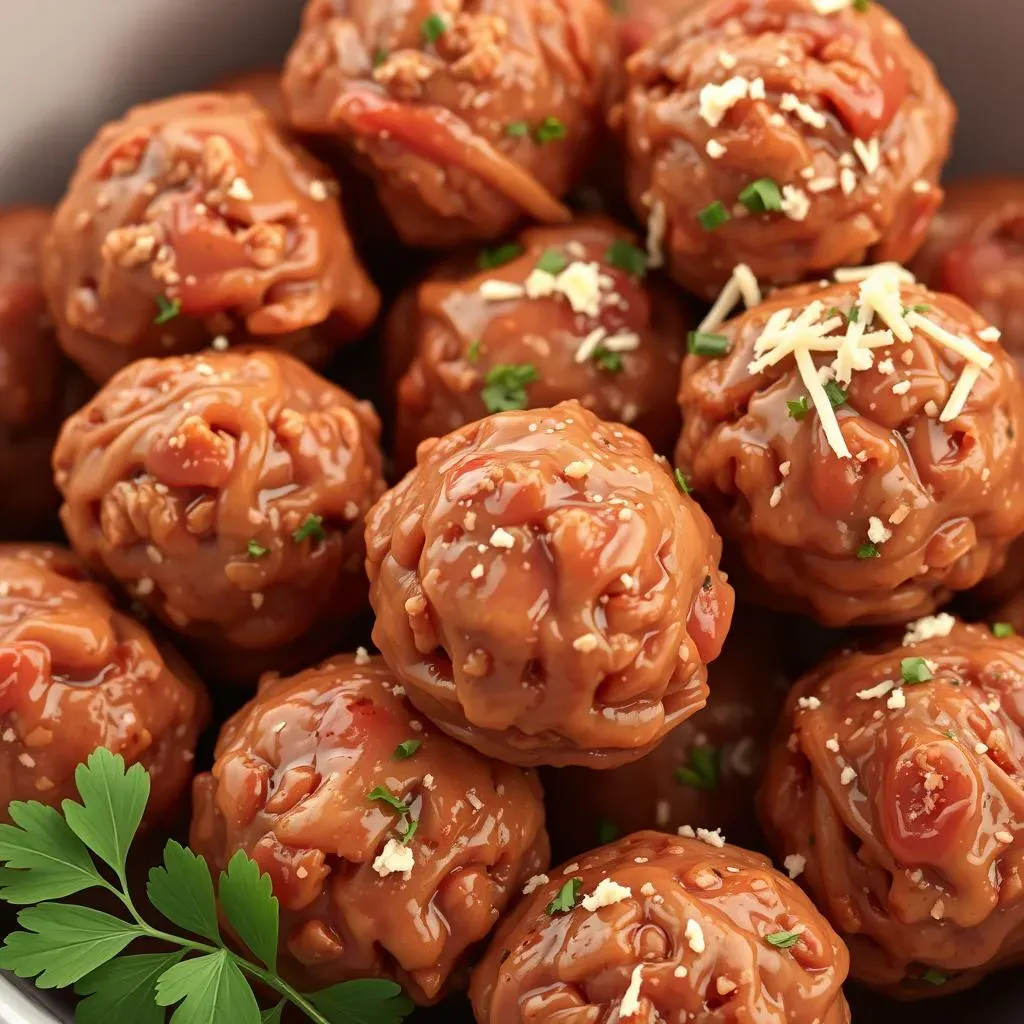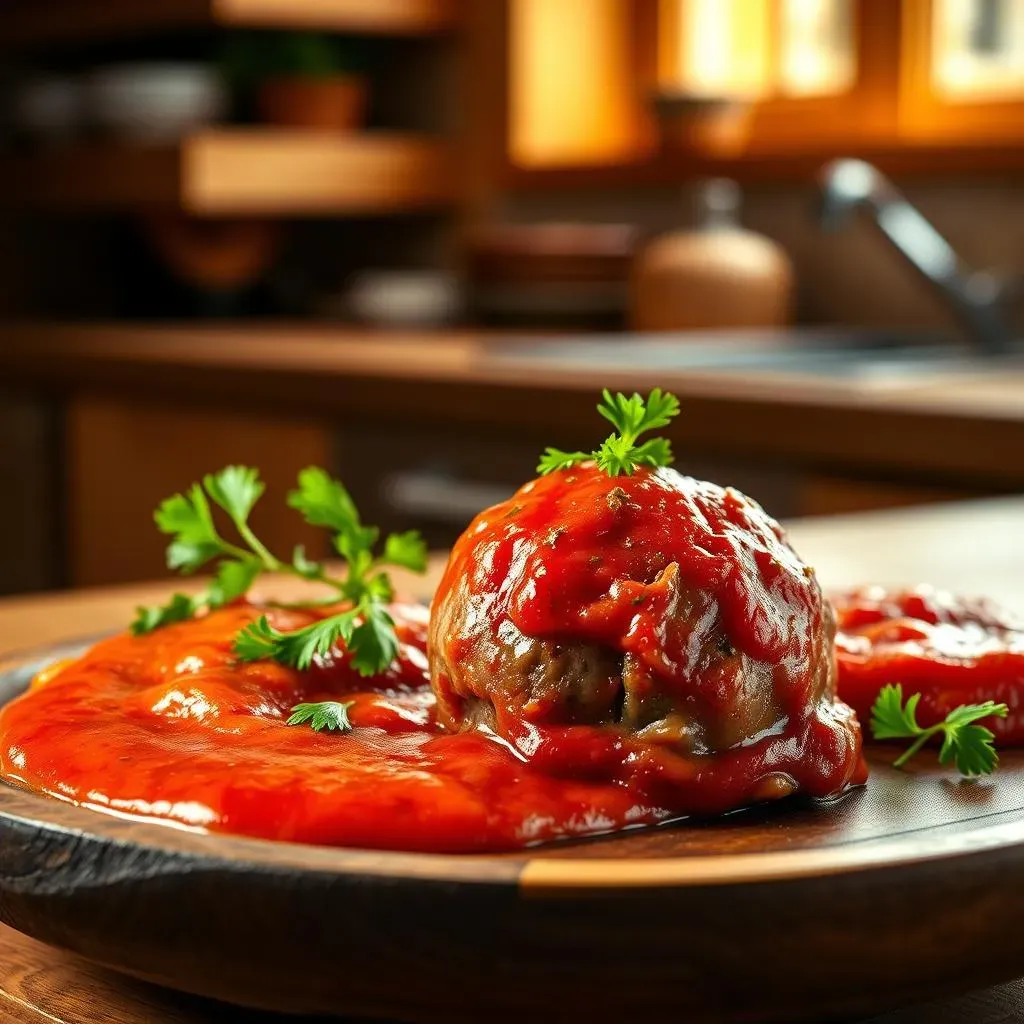Table of Contents
Are you ready to elevate your dinner game with a dish that's both classic and comforting? Then prepare yourself for a deep dive into the world of the traditional beef meatball recipe! This isn't just any meatball recipe; it's a journey through generations of culinary wisdom, a celebration of simple ingredients transformed into something truly spectacular. We'll start by exploring the heart of the matter: ingredient selection. Learn which cuts of beef create the juiciest, most flavorful meatballs, and discover the secrets to perfectly seasoned, fluffy breadcrumbs. Next, we'll walk you through a step-by-step guide, ensuring even novice cooks can achieve meatball mastery. But the fun doesn't stop there! We'll explore exciting variations on the traditional beef meatball recipe, from adding different herbs and spices to incorporating other types of meat. Finally, we'll unleash your creativity with innovative serving suggestions, transforming your meatballs from a simple dinner staple into a culinary masterpiece. Get ready to impress your family and friends with this timeless classic, perfected for the modern kitchen. This guide to the traditional beef meatball recipe will leave you confident and equipped to create the most delicious meatballs you've ever tasted.
The Heart of the Traditional Beef Meatball Recipe: Choosing the Right Ingredients

The Heart of the Traditional Beef Meatball Recipe: Choosing the Right Ingredients
The Ground Beef: Your Meatball's Foundation
Let's talk about the star of the show: the ground beef. This isn't just any ground beef; we're aiming for a balance of flavor and texture. A blend of 80/20 ground chuck and ground sirloin is a fantastic starting point. The 20% fat content ensures juicy, tender meatballs, while the sirloin adds a leaner component for a more satisfying bite. Avoid overly lean ground beef, as it can result in dry, crumbly meatballs. Remember, fat equals flavor!
For those seeking a leaner option, you could explore a higher percentage lean ground beef, but be prepared to adjust the recipe slightly. You might need to add a bit more moisture, perhaps with some milk or even finely grated zucchini, to compensate for the lack of fat. Check out our tips on for more detailed advice.
Ground Beef Type | Fat Content | Meatball Texture |
|---|---|---|
80/20 Ground Chuck | 20% Fat | Juicy and Tender |
90/10 Ground Sirloin | 10% Fat | Leaner, but potentially drier |
Breadcrumbs: The Secret to Moisture
Next up, let's talk breadcrumbs. These aren't just there for texture; they play a crucial role in retaining moisture within your meatballs, preventing them from drying out during cooking. Fresh breadcrumbs are ideal, offering a superior texture and moisture level compared to their dried counterparts. If you're making your own, use good quality bread – stale bread works best! Avoid using pre-seasoned breadcrumbs, as they could overpower the delicate flavor of your meatballs. Instead, season them yourself for better control over your recipe’s flavor profile.
However, if fresh breadcrumbs aren't available, dried breadcrumbs will work in a pinch. Just remember to adjust the quantity slightly, usually adding a bit less than what the recipe calls for. If you're aiming for a gluten-free meatball, you can easily substitute almond flour or gluten-free breadcrumbs. For more ideas, you might want to check out our .
- Fresh Breadcrumbs (best)
- Dried Breadcrumbs (good)
- Almond Flour (gluten-free option)
The Finishing Touches: Herbs, Spices, and More
Finally, let's not forget the herbs and spices that bring your meatballs to life! Fresh herbs like parsley, oregano, and basil are classic choices, lending a vibrant, herbaceous note to your meatballs. Don't be afraid to experiment with different combinations to find your perfect blend. Garlic, either fresh or powdered, is a must-have for adding depth and richness. A touch of onion, either finely chopped or powdered, adds a subtle sweetness.
And for a truly authentic touch, consider adding a little grated Parmesan or Romano cheese. This not only enhances the flavor but also helps bind the ingredients together. For those who prefer a spicier kick, a pinch of red pepper flakes can add a delightful warmth. Want some more ideas? Check out our article on for inspiration.
Mastering the Art of the Traditional Beef Meatball Recipe: A StepbyStep Guide

Mastering the Art of the Traditional Beef Meatball Recipe: A StepbyStep Guide
Mixing the Magic: Creating the Meatball Mixture
Alright, let's get our hands dirty! The first step in crafting the perfect meatball is creating a well-balanced mixture. Gently combine your chosen ground beef blend with the fresh breadcrumbs, ensuring they're evenly distributed throughout the meat. Next, add your beaten eggs – this acts as a binder, helping the meatballs hold their shape. Now, it's time for the flavor explosion: incorporate your finely chopped garlic, onion, herbs (parsley, oregano, basil – or your favorite combination!), and seasonings (salt, pepper, and perhaps a pinch of red pepper flakes for a little heat). Mix everything thoroughly, but avoid overmixing, as this can result in tough meatballs. Remember, we want tender, juicy perfection!
Once your mixture is well combined, give it a taste test! Adjust the seasoning as needed. This step is crucial for ensuring your meatballs are perfectly seasoned. If the mixture seems too dry, add a tablespoon or two of milk at a time until it reaches the desired consistency. Too wet? Add a little more breadcrumbs to absorb the extra moisture. For more detailed tips and tricks, check out our article.
- Gently combine ground beef and breadcrumbs.
- Add beaten eggs as a binder.
- Incorporate garlic, onion, herbs, and seasonings.
- Taste and adjust seasoning as needed.
- Adjust moisture with milk or breadcrumbs.
Shaping and Sizing: The Art of the Meatball
Now comes the fun part – shaping your meatballs! Using a spoon or a cookie scoop (for perfectly uniform meatballs), portion out your mixture into equal-sized balls. Aim for a size that's comfortable to eat in one or two bites. Overly large meatballs may not cook evenly, resulting in a raw center. Too small, and they might dry out too quickly. A good rule of thumb is around 1 ½ to 2 inches in diameter. Lightly oil your hands to prevent sticking. Remember, don't squeeze the mixture too tightly when shaping the meatballs; this can lead to tough, dense results.
Once you've shaped your meatballs, place them on a baking sheet lined with parchment paper or lightly oiled foil. This prevents them from sticking and makes cleanup a breeze. If you're planning to bake your meatballs, you can proceed directly to baking. However, for the most flavorful meatballs, consider lightly browning them in a skillet before baking or simmering. This step adds depth of flavor through the Maillard reaction, which creates those delicious browned bits. For more information on cooking methods, you might find our guide helpful.
Meatball Size | Cooking Considerations |
|---|---|
1 ½ - 2 inches | Ideal size for even cooking |
Larger | May require longer cooking time and may not cook evenly |
Smaller | May dry out quickly |
Cooking to Perfection: Baking, Frying, or Simmering
Now for the grand finale – cooking your meatballs! You have several options, each offering a unique flavor profile. Baking is a simple and hands-off method, resulting in tender meatballs with a slightly crispy exterior. Preheat your oven to 375°F (190°C) and bake for 20-25 minutes, flipping halfway through for even browning. Frying, on the other hand, adds a delicious crispy crust and rich flavor. Heat a tablespoon or two of olive oil in a large skillet over medium heat, and brown the meatballs on all sides, ensuring they’re cooked through.
Finally, simmering your meatballs in a rich tomato sauce is a classic approach. After browning (or baking), gently simmer your meatballs in your favorite sauce for at least 30 minutes, allowing the flavors to meld and the meatballs to become incredibly tender. This method also adds moisture, resulting in incredibly juicy meatballs. No matter your chosen method, always use a meat thermometer to ensure the internal temperature reaches 160°F (71°C) for food safety. For more ideas on cooking methods and sauce pairings, please see our recipe.
Beyond the Basics: Variations on the Traditional Beef Meatball Recipe

Beyond the Basics: Variations on the Traditional Beef Meatball Recipe
Spice it Up: Exploring Flavor Profiles
Let's face it, the beauty of a traditional beef meatball recipe lies in its adaptability. Once you've mastered the basics, the world of flavor combinations opens up! Want a bit of heat? A pinch of red pepper flakes or a dash of your favorite hot sauce can transform your meatballs into a fiery delight. Feeling adventurous? Explore different herbs and spices! Instead of the classic parsley and oregano, try adding a Mediterranean twist with fresh mint and a touch of cumin. Or, for something completely different, consider a zesty Asian-inspired meatball with ginger, soy sauce, and sesame oil. The possibilities are endless!
Don't be afraid to experiment with different cheeses, too! While Parmesan is a classic choice, consider Pecorino Romano for a sharper, more intense flavor, or Asiago for a nutty, slightly sweet taste. You could even try a blend of cheeses for a truly unique flavor profile. For inspiration on unique flavor combinations, check out our article.
- Add red pepper flakes for heat.
- Experiment with different herbs (mint, cumin).
- Try Asian-inspired flavors (ginger, soy sauce).
- Use different cheeses (Pecorino Romano, Asiago).
Meatball Makeovers: Beyond Beef
While beef is the traditional star, there's no rule saying you can't branch out! For a leaner option, try incorporating ground turkey or chicken. Just be mindful that these leaner meats can dry out more easily, so you might need to adjust the recipe by adding extra moisture, such as milk or finely grated vegetables. For a richer, more decadent meatball, consider adding ground pork or even a touch of ground sausage. The addition of pork will enhance the juiciness and add a delightful savory depth of flavor.
Alternatively, you could create a truly unique meatball by incorporating other proteins, such as ground lamb or even finely chopped mushrooms for a vegetarian option. Remember to adjust the seasoning to complement the new protein you choose. Want to explore more meatball variations? Our article on offers some great starting points.
Meat Type | Flavor Profile | Moisture Considerations |
|---|---|---|
Ground Turkey/Chicken | Leaner, milder flavor | May require extra moisture |
Ground Pork/Sausage | Rich, savory flavor | Naturally juicier |
Ground Lamb | Gamey, robust flavor | Similar moisture to beef |
Creative Cooking Methods: Beyond the Basics
While baking and frying are classic methods, don’t limit yourself! Consider slow cooking your meatballs in a flavorful broth for incredibly tender results. This is a fantastic method for infusing the meatballs with deep, rich flavors. Or, try using an Instant Pot for a quicker cooking time, while still achieving tender, juicy results. You can even experiment with grilling your meatballs for a smoky char, perfect for summer barbecues. Just remember to adjust cooking times based on the size and cooking method you choose.
No matter your chosen cooking method, always ensure your meatballs reach a safe internal temperature of 160°F (71°C) to prevent foodborne illness. For more ideas on different cooking techniques, you might want to check out our recipe and our guide.
Serving Suggestions for Your Traditional Beef Meatball Recipe: From Classic to Creative

Serving Suggestions for Your Traditional Beef Meatball Recipe: From Classic to Creative
Classic Comfort: Spaghetti and Meatballs
Let's start with the quintessential meatball experience: spaghetti and meatballs! This classic combination is a crowd-pleaser for a reason. The rich, savory meatballs pair perfectly with the smooth, comforting texture of spaghetti, creating a harmonious blend of flavors and textures. A simple yet delicious marinara sauce ties it all together, enhancing the overall experience. For a truly authentic touch, top your dish with freshly grated Parmesan cheese and a sprinkle of chopped fresh basil.
To make this dish even more special, consider adding some sauteed vegetables like zucchini or mushrooms to your sauce, or try a different type of pasta. Linguine or fettuccine could also be a great choice, depending on your preference. For a complete guide on creating a truly perfect pasta dish, check out our article on .
- Spaghetti
- Linguine
- Fettuccine
Beyond the Bowl: Meatball Subs and Sliders
Want to take your meatballs on the go? Meatball subs and sliders are the perfect solution! The hearty, flavorful meatballs nestled in a toasted roll, topped with your favorite sauce and cheese, create a satisfying and portable meal. For a classic Italian-American experience, use a crusty Italian roll and a rich marinara sauce. But don't be afraid to get creative! Try different types of bread, such as ciabatta or focaccia, or experiment with different sauces, such as a creamy pesto or a spicy arrabbiata sauce.
For a fun twist, consider making mini meatball sliders. These are perfect for parties or casual gatherings. Serve them alongside a variety of dipping sauces or toppings to allow guests to customize their own sliders. For more serving ideas, you can check out our recipe.
Roll Type | Sauce Suggestion |
|---|---|
Italian Roll | Marinara |
Ciabatta | Pesto |
Focaccia | Spicy Arrabbiata |
Global Inspiration: Meatball Fusion
Ready to venture beyond the traditional? Let's explore some global-inspired meatball creations! Imagine your perfectly seasoned meatballs in a vibrant Thai green curry, or nestled in a fragrant Indian tikka masala sauce. The possibilities are truly endless! You can adapt your meatballs to suit a wide range of cuisines, creating exciting and unexpected flavor combinations. For a Japanese twist, serve your meatballs with a teriyaki glaze and a side of rice. Or, for a Mediterranean flair, top them with tzatziki sauce and serve with pita bread.
Don't be afraid to experiment with different spices, sauces, and sides to create your own unique culinary masterpiece. The key is to have fun and let your creativity guide you! For more globally inspired ideas, check out our .
- Thai Green Curry Meatballs
- Indian Tikka Masala Meatballs
- Japanese Teriyaki Meatballs
- Mediterranean Tzatziki Meatballs
Meatball Makeovers: Creative Serving Styles
Let's move beyond the classic serving styles. Think outside the box! Instead of serving your meatballs simply on a plate of pasta, consider incorporating them into a hearty soup, such as a flavorful meatball soup. Or, create a comforting meatball casserole, layering your meatballs with creamy cheese sauce, vegetables, and pasta. For a lighter option, serve your meatballs as a topping for a fresh salad, adding a burst of protein and savory flavor. The possibilities are endless!
You can also get creative with presentation. Arrange your meatballs beautifully on a platter, perhaps with a colorful garnish, for a stunning visual appeal. These creative serving styles will not only enhance the taste but also add a touch of elegance to your meal. For more unique ideas, you might find inspiration in our recipe.
Serving Style | Description |
|---|---|
Meatball Soup | Hearty and comforting |
Meatball Casserole | Layered and cheesy |
Meatball Salad Topping | Light and refreshing |